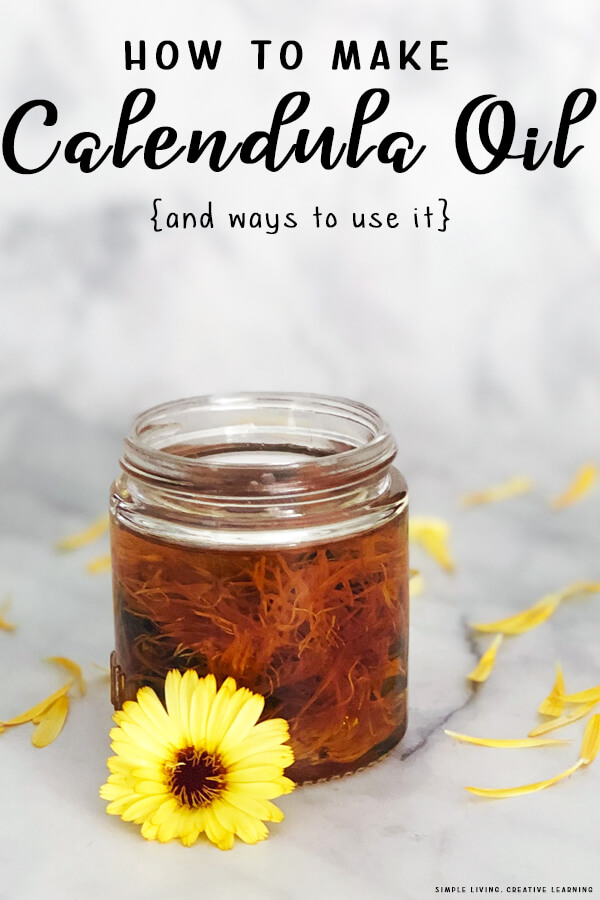Calendula officinalis, also known as ‘pot marigold’ has a long history of use in both folk medicine and culinary traditions. Learn how to make your own natural calendula oil and ways to use it.
Calendula Oil
Calendula oil is simply oil that has been infused with dried calendula flowers. Whole dry flower heads or just the petals can be used, but it is important that they are dried before using them, as too much moisture can make the oil go rancid. Once steeped, the oil can be either used on its own or made into natural salves, ointments and creams. If you steep with an inedible oil such as jojoba, then you would not be able to use as a salad dressing.
Calendula works gently, aiding in cell repair and growth with its natural antiseptic, anti-fungal and anti-inflammatory properties. Growing your own flowers and using them to make this oil is very affordable while being simple and pure.
Using Calendula Oil
Calendula is often used in first aid and for healing including:
- Cuts and Scrapes
- Bug Bites
- Soothe sunburn
- Face and lip care
- Diaper rash
- Dry or chapped skin
- A rinse for pinkeye
- Relief for sore throats
- Calendula Salve
- Salad dressing – used in place of plain olive oil
- Charcoal Drawing Salve
The petals of the flowers can also be added to butter, cheese and custards, helping to enhance the colour or can be processed and used in teas.
Sometimes, it may be used as a substitute for saffron, as it is quite similar.
For this Calendula Oil recipe, oil is used to extracted by infusing the petals of the flowers in a carrier oil, such as olive oil. Once infused and strained, this oil can be used on its own or to make ointments, creams and salves. Infused oils are not essential oils, they are very different and I don’t recommend internal use for essential oils. Calendula oil is also not recommended for internal use during pregnancy and breastfeeding or when taking any type of sedative drugs. Those who are allergic to ragweed/chamomile/Asteraceae/Compositae family may also find that they may be sensitive to calendula, so please be careful when using. Stop use immediately if signs of a rash occur. Also, it is advised to not apply oils to fresh burns, fungal infections and leaky skin conditions, a water-based poultice would be better in this situation.
More Calendula Resources
- How to make Calendula Oil
- Homemade Calendula Soap
- How to Grow, Harvest and Dry Calendula
- Calendula Fizzy Bath Powder
- Calendula Bath Bombs
Making Calendula Infused Oil – The Slow Method
This is the method that I use as it is believed that it preserves the calendula best. There is also a faster method below, for those who don’t have 4 – 6 weeks to wait.
You will need:
- Dried, organic calendula petals
- Olive oil – Almond and avocado oils are other good options
Place the petals in a large clean, dry glass jar.
Pour in the olive oil so that the petals are covered with 1 inch of oil as the petals will expand as they soak in the liquid and they need to stay covered the whole time. You will find that the petals will float, so an easy way is to make sure there is about 1 inch of oil clear at the bottom of the jar.
Cover the jar with a tight fitting lid and give it a good shake. Place the jar dark, cool place.
Infuse for 4 – 6 weeks, shaking every couple of days when you walk past. Then strain out the petals using a cheesecloth and pour the oil into a clean, glass jar. Store in a cool, dark place while using.
More Homemade Resources
- 35+ Self Care Products to Make
- Homemade Vapour Rub
- Homemade Dishwasher Tablets
- All Purpose Cleaner
- Toilet Bowl Cleaning Powder
- DIY Glass and Mirror Cleaner
- DIY Hand Sanitiser
- Soft Scrub Cleaner
- DIY Purfumes
- Lavender Bath Bombs
- Magnesium Body Lotion
- Cracked Foot & Heel Balm
- Citrus Soap
- Toilet Cleaning Bombs
- Grapefruit and Mint Soap
Making Calendula Infused Oil – The Quick Method
You will need:
- Dried, organic calendula petals
- Olive oil – Almond and avocado oils are other good options
Place the petals in a a clean, dry glass jar.
Pour in the olive oil so that the petals are covered with 1 inch of oil as the petals will expand as they soak in the liquid and they need to stay covered the whole time. You will find that the petals will float, so an easy way is to make sure there is about 1 inch of oil clear at the bottom of the jar.
Cover the jar with a tight fitting lid and give it a good shake.
Place a tea towel in the bottom of your slow cooker and place your jar inside. Add enough water to cover about half the jar.
Set on the lowest temperature for 2-6 hours. I usually set mine to warm.
Strain out the petals using a cheesecloth and pour the oil in to a clean, glass jar. Store in a cool, dark place while using.


 {FREE} Christmas Notebooking Pack
{FREE} Christmas Notebooking Pack